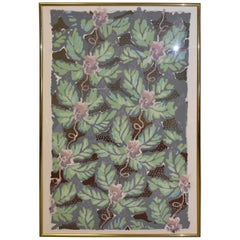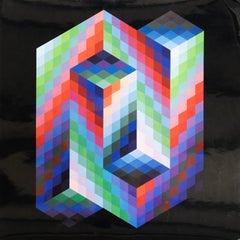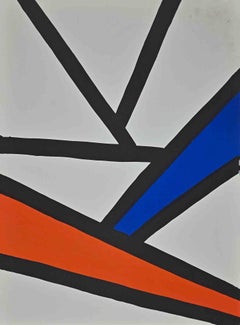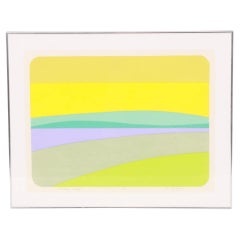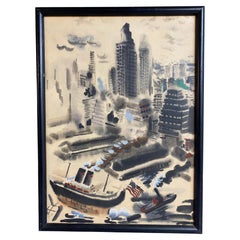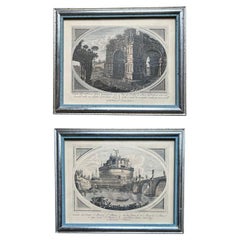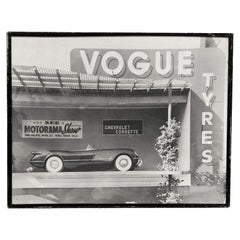Vintage Lithograph Prints
1980s Unknown Modern Vintage Lithograph Prints
Paper
1960s Modern Vintage Lithograph Prints
Lithograph
20th Century Op Art Vintage Lithograph Prints
Offset
1960s Abstract Vintage Lithograph Prints
Lithograph
Late 20th Century American Mid-Century Modern Vintage Lithograph Prints
Paper
1960s American Mid-Century Modern Vintage Lithograph Prints
Wood, Paper
Mid-20th Century Italian Rococo Revival Vintage Lithograph Prints
Metal
1990s Modern Vintage Lithograph Prints
Lithograph
1950s American Mid-Century Modern Vintage Lithograph Prints
Glass, Wood, Paper
1960s Modern Vintage Lithograph Prints
Lithograph
1970s Mid-Century Modern Vintage Lithograph Prints
Paper
Late 20th Century Cubist Vintage Lithograph Prints
Lithograph
1950s French Mid-Century Modern Vintage Lithograph Prints
Paper
1940s Vintage Lithograph Prints
Paper
Late 20th Century American Mid-Century Modern Vintage Lithograph Prints
Glass, Wood, Paper
1990s Vintage Lithograph Prints
Canvas, Acrylic
Late 20th Century Vintage Lithograph Prints
Lithograph
1980s Spanish Modern Vintage Lithograph Prints
Other
20th Century Vintage Lithograph Prints
Lithograph
20th Century Vintage Lithograph Prints
Lithograph
1960s Modern Vintage Lithograph Prints
Lithograph
1970s Abstract Vintage Lithograph Prints
Lithograph
20th Century Vintage Lithograph Prints
Lithograph
1940s Modern Vintage Lithograph Prints
Lithograph
1970s Mid-Century Modern Vintage Lithograph Prints
Wood, Paper
1980s French Mid-Century Modern Vintage Lithograph Prints
Paper
1970s Contemporary Vintage Lithograph Prints
Lithograph
Mid-20th Century Modern Vintage Lithograph Prints
Lithograph
1940s Modern Vintage Lithograph Prints
Lithograph
20th Century Vintage Lithograph Prints
Lithograph
Late 20th Century Vintage Lithograph Prints
Lithograph
1950s Modern Vintage Lithograph Prints
Lithograph
Mid-20th Century Modern Vintage Lithograph Prints
Lithograph
Mid-20th Century American Vintage Lithograph Prints
Paint, Paper
1980s Dutch Modern Vintage Lithograph Prints
Pine
1990s Surrealist Vintage Lithograph Prints
Lithograph, Screen
20th Century American Modern Vintage Lithograph Prints
Lithograph
1960s Modern Vintage Lithograph Prints
Lithograph
1960s Modern Vintage Lithograph Prints
Lithograph, Stencil
1940s Modern Vintage Lithograph Prints
Lithograph
20th Century Vintage Lithograph Prints
Gold, Silver
20th Century Vintage Lithograph Prints
Gold, Silver
1970s Post-War Vintage Lithograph Prints
Lithograph
1970s Post-War Vintage Lithograph Prints
Lithograph
1970s Post-War Vintage Lithograph Prints
Lithograph
1970s Post-War Vintage Lithograph Prints
Lithograph
1970s Post-War Vintage Lithograph Prints
Lithograph
1970s Post-War Vintage Lithograph Prints
Lithograph
1970s Post-War Vintage Lithograph Prints
Lithograph
1970s Post-War Vintage Lithograph Prints
Lithograph
1970s Post-War Vintage Lithograph Prints
Lithograph
1970s Post-War Vintage Lithograph Prints
Lithograph
1970s Post-War Vintage Lithograph Prints
Lithograph
1970s Post-War Vintage Lithograph Prints
Lithograph
1970s Post-War Vintage Lithograph Prints
Lithograph
1970s Post-War Vintage Lithograph Prints
Lithograph
1970s Post-War Vintage Lithograph Prints
Lithograph
1970s Post-War Vintage Lithograph Prints
Lithograph
1970s Post-War Vintage Lithograph Prints
Lithograph
1960s Abstract Vintage Lithograph Prints
Paper, Lithograph
- 1
- ...
Vintage Lithograph Prints For Sale on 1stDibs
How Much are Vintage Lithograph Prints?
Finding the Right Prints-works-on-paper for You
Decorating with fine art prints — whether they’re figurative prints, abstract prints or another variety — has always been a practical way of bringing a space to life as well as bringing works by an artist you love into your home.
Pursued in the 1960s and ’70s, largely by Pop artists drawn to its associations with mass production, advertising, packaging and seriality, as well as those challenging the primacy of the Abstract Expressionist brushstroke, printmaking was embraced in the 1980s by painters and conceptual artists ranging from David Salle and Elizabeth Murray to Adrian Piper and Sherrie Levine.
Printmaking is the transfer of an image from one surface to another. An artist takes a material like stone, metal, wood or wax, carves, incises, draws or otherwise marks it with an image, inks or paints it and then transfers the image to a piece of paper or other material.
Fine art prints are frequently confused with their more commercial counterparts. After all, our closest connection to the printed image is through mass-produced newspapers, magazines and books, and many people don’t realize that even though prints are editions, they start with an original image created by an artist with the intent of reproducing it in a small batch. Fine art prints are created in strictly limited editions — 20 or 30 or maybe 50 — and are always based on an image created specifically to be made into an edition.
Many people think of revered Dutch artist Rembrandt as a painter but may not know that he was a printmaker as well. His prints have been preserved in time along with the work of other celebrated printmakers such as Pablo Picasso, Salvador Dalí and Andy Warhol. These fine art prints are still highly sought after by collectors.
“It’s another tool in the artist’s toolbox, just like painting or sculpture or anything else that an artist uses in the service of mark making or expressing him- or herself,” says International Fine Print Dealers Association (IFPDA) vice president Betsy Senior, of New York’s Betsy Senior Fine Art, Inc.
Because artist’s editions tend to be more affordable and available than his or her unique works, they’re more accessible and can be a great opportunity to bring a variety of colors, textures and shapes into a space.
For tight corners, select small fine art prints as opposed to the oversized bold piece you’ll hang as a focal point in the dining area. But be careful not to choose something that is too big for your space. And feel free to lean into it if need be — not every work needs picture-hanging hooks. Leaning a larger fine art print against the wall behind a bookcase can add a stylish installation-type dynamic to your living room. (Read more about how to arrange wall art here.)
Find fine art prints for sale on 1stDibs today.
- 1stDibs ExpertNovember 20, 2024The difference between a lithograph and a lithograph print depends on the context. By the strictest definition, the terms are actually synonyms. A lithograph is the term for a print produced through a specific process. It begins with an artist drawing or painting on a stone surface with an oil-based substance, such as a greasy crayon or tusche. The stone is then covered with water, which is repelled by the oily areas. Oil-based ink is then applied to the wet stone, adhering only to the oily image. The stone is then covered with a sheet of paper and run through a press. You can call a print produced with this printmaking method a lithograph, a lithograph print or a lithographic print. However, some people may use the term lithograph to describe a traditional lithograph and lithograph print to denote an offset lithograph. Offset lithography is a method of mass-producing prints where the image from the stone gets transferred to a rubber blanket, which is then pressed against the paper to produce a final image. Find a wide variety of lithographs on 1stDibs.
- 1stDibs ExpertAugust 15, 2024To tell the difference between a lithograph and a print, touch the surface of the piece. Lithographs will usually have a slightly raised texture, whereas reproductions of lithographs produced with other techniques are more likely to be smooth. Then, examine the surface closely with a magnifying glass.
On a lithograph, you will typically see irregularities in the dot pattern. Printed reproductions normally don't display such irregularities due to the mechanical processes used to produce them. If you're still uncertain, a certified appraiser or knowledgeable art dealer can help you determine whether a piece is a lithograph or a reproduction print.
On 1stDibs, explore a large selection of lithographs and prints. - 1stDibs ExpertJune 13, 2024The difference between a print and a lithograph is that “print” is a general term and “lithograph” is a specific printing method (one of the most commonly used in the 20th and 21st centuries). This means that a lithograph is always a print, but not all prints are lithographs. A print is a work of art made by imprinting a design from a matrix made of one of the following media: stone, wood or metal. The artist creates the design on the matrix which is then inked and transferred onto the support. The support is usually made of paper. With respect to lithography, the process begins by drawing on or painting on a stone surface with an oil-based substance, such as a greasy crayon or tusche (an oily wash). The stone is then covered with water, which is repelled by the oily areas. Oil-based ink is then applied to the wet stone, adhering only to the oily image. The stone is then covered with a sheet of paper and run through a press.
Find lithographs and other types of art prints for sale on 1stDibs. - 1stDibs ExpertNovember 26, 2024To identify a lithograph print, begin by conducting a reverse image search. By taking a photo with your mobile device and performing a reverse image search, you may quickly find a match and learn the artist, title and other characteristics of your lithograph. Should this method of identification yield no results, look for an artist's signature or publisher's information on the front or back of the piece. Researching the maker or publisher via trusted online resources can help you learn more about your print. For help with the process, consult a certified appraiser or experienced art dealer. On 1stDibs, shop a wide range of lithograph prints.
- 1stDibs ExpertFebruary 13, 2023Whether lithograph prints are worth anything depends on a number of factors. Some things that may help determine the value of a given print include who the printmaker was, what the subject matter is / what the specific print is and how many lithographs were made in the series. The condition of the print as well as the market for the artist will also play a role in determining how much it's worth. Experts recommend that you consult a certified appraiser or experienced art dealer for assistance. On 1stDibs, shop a range of lithograph prints from some of the world's top galleries.
- 1stDibs ExpertApril 5, 2022There are a few things to look for in a vintage lithograph. First, check for a signature to determine the artist. Another check is to examine the print with a magnifying glass. There will be a dot pattern from the tooth of the surface it was drawn on. On 1stDibs, find a variety of vintage lithograph artwork from top artists.
- 1stDibs ExpertOctober 7, 2024The difference between a lithograph and a limited edition print is the specificity of the terms. A limited edition print is any artwork that an artist produces in a limited number for sale to collectors. A lithograph is one type of print that may be made available as a limited edition. To make a lithograph, the artist draws or paints on a stone surface with an oil-based substance, such as a greasy crayon or oily wash known as a tusche. The stone is then covered with water, which is repelled by the oily areas. Oil-based ink is then applied to the wet stone, adhering only to the oily image. The stone is then covered with a sheet of paper and run through a press. Beyond lithographs, limited edition prints can be woodblock prints, engravings, screenprints, monoprints and other types of prints. Find a diverse assortment of lithographs and other prints on 1stDibs.
Read More
Joan Mitchell’s Rare, Late-Career Diptych Buzzes with Life
Beneath the inky blackness, the painter’s irrepressible energy electrifies this pair of intaglio prints.
The 1stDibs Guide to Types of Abstract Art
Get to know the key movements and artists who have influenced visual culture for more than a century.
Romare Bearden’s Humanity Infuses His Bright, Bold Art
Through collage, painting and printmaking, the artist foregrounded Black life in America in revolutionary new ways.
Andy Warhol and Suzie Frankfurt’s ‘Wild Raspberries’ Cookbook Is an Artful, Fanciful Delight
This set of recipes and original prints might not make you a better chef. But it will make you smile.
Art Brings the Drama in These Intriguing 1stDibs 50 Spaces
The world’s top designers explain how they display art to elicit the natural (and supernatural) energy of home interiors.
Welcome (Back) to the Wild, Wonderful World of Walasse Ting
Americans are rediscovering the globe-trotting painter and poet, who was connected to all sorts of art movements across a long and varied career.
Shapero Modern’s Director Tells Us All about 20th-Century Prints
Tabitha Philpott-Kent knows a lot of art multiples. Here, the London gallery director talks about what makes printmaking so fabulous.
Yoshitomo Nara Puts a Punk Rock Twist on the Traditional Prints of His Ancestors
The forever-rebellious Japanese artist craftily defaces famous Edo Period woodblock prints with “In the Floating World.”
